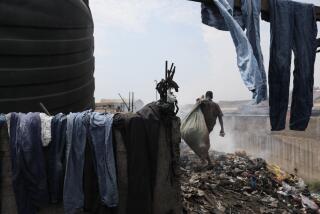Garment Industry Provides a Chance for Independence
- Share via
DHAKA, Bangladesh — Samsun Nahar bent over a sewing machine and attached a sleeve to the bright red shirt. Her bony fingers worked quickly, stopping once to adjust her glasses.
The 37-year-old woman with graying hair makes $45 for a month of 12-hour days and six-day weeks stitching together the shirts, which eventually will sell for $14.99 in a K mart in the United States.
“I didn’t work when my husband was alive, but after he died I was compelled to come here,” she said. “I didn’t like it at first. I never thought I’d have to have a job, go out of the house every day. But now I like it.”
She works in one of about 450 garment factories that have sprung up around the capital of Bangladesh over the last five years. The industry was born almost overnight to fill a need.
When the U.S. government tightened trade quotas on other Asian countries--including Taiwan, South Korea, the Philippines and Hong Kong--Bangladeshi businessmen saw their chance. The factories exported more than $260 million worth of finished goods to the United States last year, making Bangladesh the fifth-largest exporter of finished clothing to the United States, after Hong Kong, South Korea, Thailand and Mexico.
Although the fledgling industry is locally owned and employs only Bangladeshis, it does not have a massive effect on the more than 50% unemployment and underemployment rate. Nearly all of the materials--from finished cloth to buttons, hangers and price tags--are imported from Thailand or Hong Kong, so there is no spinoff employment. But it does provide more than 150,000 jobs, most of them for women.
“Between 70% and 75% of the workers are women,” said Mohammad Giasuddin Khan, who runs the YK garment company, a 600-worker plant on the second and third floors of a crowded factory building in the center of Dhaka, churning out shirts, blouses and skirts for K mart and J. C. Penney, among others.
“When the women first come, they have no self-confidence. Half of them are widowed or divorced, the sole provider for the family,” he said. “This job doesn’t change their social status. But they are more confident. It is still poverty, but it is no longer hand to mouth.”
Fheuli appears no older than 10, but claims to be 13, the age at which children can work in factories. She is approaching the end of her training program. Her job is to put an ironed shirt on a hanger and attach the K mart price tag.
“It is a good job,” she said, looking her questioner right in the eye, something that is unusual among non-working Bangladeshi women, who avoid eye contact with men. She said she earns about $20 a month, which will double when she is promoted to “skilled worker.”
Fheuli, like virtually all the garment-industry employees, works a 72-hour week, despite an equal employment law that says women and children cannot work more than 10 hours a day. An official in the prime minister’s office admitted that the government does not try to enforce the law.
“We can’t really enforce it and most of the garment factories aren’t that bad,” he said. “It isn’t heavy manual labor, which is what the law was intended to protect women from.”
Feminists say that the women are exploited, but are reluctant to press the point because the factories are one of the few employment opportunities for women.
“Eighty percent of the garment workers are severely exploited,” said Aeyasa Khanam, one of Bangladesh’s few women’s rights activists. “They are denied trade union rights, they are treated as temporary workers with no benefits. . . . But it is a step in the right direction, allowing a woman to go out and earn on her own.”
More to Read
Sign up for Essential California
The most important California stories and recommendations in your inbox every morning.
You may occasionally receive promotional content from the Los Angeles Times.










